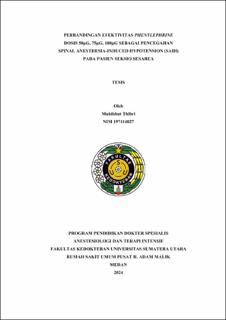Perbandingan Efektivitas Phenylephrine Dosis 50μg, 75μg, 100μg sebagai Pencegahan Spinal Anesthesia-Induced Hypotension (SAIH) pada Pasien Seksio Sesarea
Comparison of Phenylephrine Effectiveness Dosage 50μg, 75μg, 100μg as Prevention Spinal Anesthesia-Induced Hypotension (SAIH) in Caesarea Section Patients

Date
2024Author
Thibri, Muhibbut
Advisor(s)
Wijaya, Dadik Wahyu
Bisono, Luwih
Metadata
Show full item recordAbstract
Background:
Spinal Anesthesia-Induced Hypotension (SAIH) is a physiological response during
cesarean section under spinal anesthesia contributing to nausea, vomiting,
dizziness, and even cardiovascular collapse in Moms. Phenylephrine is an α-
adrenergic receptor agonist has been associated with nadi slowing and even a dosedependent
decrease in cardiac output. The current standard to avoid maternal
hypotension and blood pressure variability is to provide a continuous infusion of
phenylephrine to limit changes from baseline.
Objective:
To analyze the comparative effectiveness of various doses of phenylephrine 50μg,
75μg, 100μg on the prevention of SAIH in cesarean section patients at H. Adam
Malik General Hospital, Hajj General Hospital Medan, Pirngadi Hospital Medan
and Rumkit Tk-II Putri Hijau Medan.
Methods:
This study used Randomized Clinical Trial design with double blind. Samples were
divided based on phenylephrine dose: group 1 (50μg), group 2 (75μg), and group 3
(100μg). Data will be analyzed by Annova test or Kruskal Wallis test. Post hoc test
was then conducted to see the difference between groups.
Results:
There were 47 samples with a distribution of 16 samples of group 1, 16 samples of
group 2, and 15 samples of group 3. In the analysis of variables of age, height,
weight, and BMI, it was found that there were no statistically significant differences
between treatment groups (p=0.950, p=0.468, p=0.763, and p=0.647). It was found
that systolic and diastolic blood pressure data had significant differences in T1
(p=0.020 and p=0.004) and T2 (p=0.018 and p=0.046) measurements. It was found
that MAP data had significant differences in measurements T1 (p=0.004), T2
(p=0.046), and T6 (0.035). It was found that nadi data at measurement T5 (p=0.017)
had a significant difference.
Conclusion:
The most effective dose of phenylephrine in preventing SAIH was 75μg, then 50μg,
and 100μg. Although clinically all doses were considered effective in preventing
SAIH.
Collections
- Master Theses [177]
